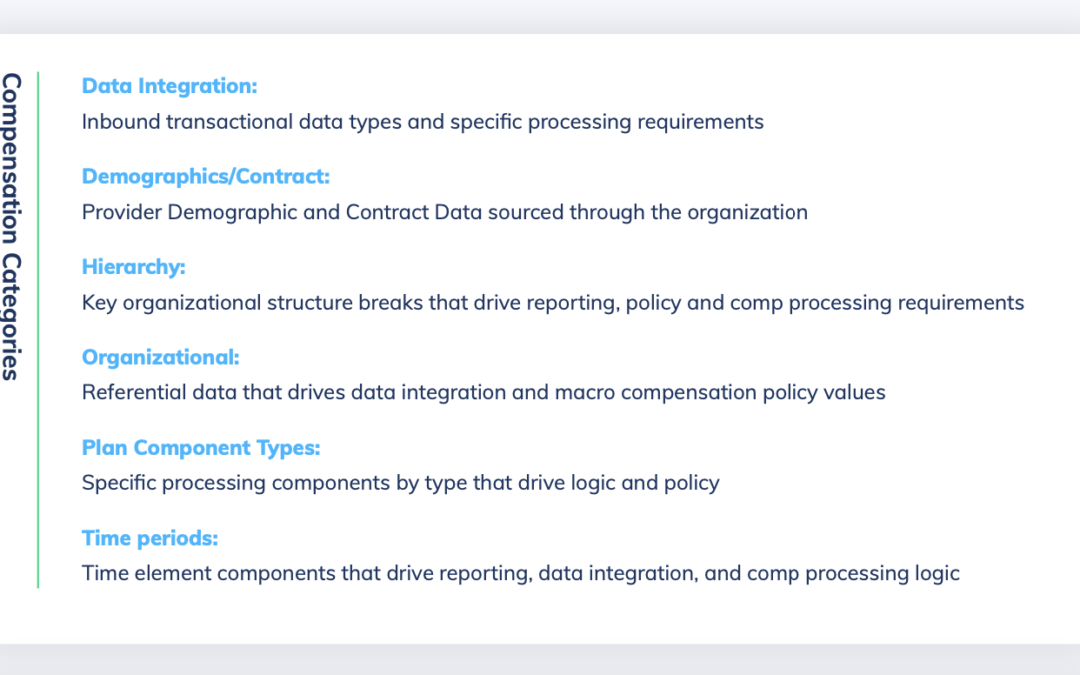In the rapidly evolving landscape of healthcare, the need for advanced compensation methodologies has become increasingly apparent. The traditional approach of relying solely on relative value units (RVUs) and simple production-based models has proven inadequate in valuing providers’ time and aligning organizational goals.
Oversimplified models or deploying technology that does not manage all aspects of your processes will constrain your organization’s ability to adapt and scale.
To address these challenges, the adoption of smart compensation models has emerged as a key solution, emphasizing holistic value, collaborative teamwork, and overall system success.
This article delves into the intricacies of implementing smart compensation models and their potential to revolutionize the future of healthcare compensation.
Signs of Ineffective Comp Management
Recognizing the signs of ineffective compensation management is crucial in highlighting the deficiencies of conventional models.
Symptoms such as a lack of cohesion within provider groups, turnover, and the inability of operational and clinical leaders to prioritize organizational goals (such as service line growth) due to misaligned compensation structures underscore the urgency for a paradigm shift in compensation strategies. Perhaps you have models that are driving the right behaviors and strategy, but the process of managing those and evolving over time requires too much organizational bandwidth. Conversely, you may have the need to add more considerations into your plan logic to incentivize growth and collaboration, but it requires month-over-month manual work that can easily be a source of error as steps get missed.
When you have manual processes or a technology offering that does not manage the entire process, your organization will continue to see these symptoms and this will further hamper evolution and growth.
The first step is to ensure your process is automating, linking, and transforming all data, including:
- Organizational data
- Contract attributes
- User profile/ access details
- Compensation reports/summaries/visualization
- Transactional data
It also includes all the data normalization, assignment, adjustment, and validation that allows for all supporting calculations and outputs such as:
- Value
- Panel
- Accruals
- Payfiles
- One-off payments
- Leadership payments
- Exceptions
- Leave of absences
- Termination payments
- New hire logic
- Shift compensation
- Guarantees
- FTE allocations
- FMV analytics
- Prorated providers
- Contract year to date
- Rolling calculations
- Hierarchical Goal management (specialty, group, team, service line, etc.)
If your technology and processes are not equipped to deal with complexities – or they need to be handled outside of the system – these items become nearly impossible to manage when you look to introduce teams, pools, and more complicated value strategy models. Additionally, you’ll see little relief or additional capabilities to move into the future.
The Benefits of Holistic Compensation Approaches
One of the primary drawbacks of focusing solely on production-based incentives is the oversight of crucial organizational aspects beyond mere output. While production remains a vital component, it fails to encompass the broader spectrum of factors influencing provider performance and system success.
Therefore, the transition to holistic compensation approaches, which consider value, teamwork, and adaptable models, is critical to addressing the limitations of traditional compensation systems.
Examples of ‘Smart Models’ in Compensation
Smart models in compensation represent a departure from static, one-dimensional frameworks. These models are designed to adapt and recalibrate over time, incorporating nuanced parameters based on organizational hierarchies and multifactorial goal achievements.
By considering various elements such as cost centers, departmental divisions, group dynamics, specialties, regions and roles, these models ensure a fair and dynamic compensation structure that accounts for diverse contributions within the healthcare ecosystem.
ProCARE Smart Model Example
The smartest models we’ve automated to date use a base salary that resets several times a year based on a rolling 12-month production, but then still allows for increases on top of the guarantee.
This de-risks the process for both the organization and providers while providing space on both sides for providers to have down months to grow service lines and still recover in future months. Additionally, these smart models have components such as Production and Value, which carry an individual and team component or even additional breaks for service lines, entire organization components, etc. This increases the teamwork element and brings back groupness to your organization, which is a vital element absent in many over-streamlined models. Quality Funding pools can then be based on these core model components such as total earned comp.
When it comes to smart value-based models, even if you have robust quality analytics, there are still many gaps in transforming and using that data for compensation.
Your organization should be able to select from a variety of CMS-based measures, Board initiatives, or other operational data points like panel or patient satisfaction within your comp tool and assign those to specific providers based on organization attributes and manage goals, targets and payment logic across all those attributes.
The organization attributes that drive these assignments should be automatically managed by data feeds and the calculation and assignment of measures from data are automated and assigned automatically.
ProCARE Example: the ability to toggle measures on/off for compensation and/or reporting by Group, Speciality, Team, Region, Service Line, etc, and manage the goals, target, threshold, and payment logic by each of these breaks. For example, one measure for readmission could have different goals and payout logic by region, plan, specialty, group, etc. all easily managed in one table.
Inbound quality data should be scrubbed as needed and assigned to each provider based on these breaks so a provider can see and be compensated for their individual performance and the various organizational levels (specialty, group, etc) that are important to the organization. These items should work with little to no ongoing maintenance unless measure assignment or target/threshold changes are necessary and even that should be streamlined and efficient.
Implementing Smarter Models: Key Considerations
Introducing smarter models necessitates a shift in mindset and a comprehensive approach to compensation design.
Additionally, organizations must prioritize the integration of data from various sources, enabling automated adjustments and a more comprehensive understanding of the metrics driving compensation decisions.
The incorporation of adaptable models that facilitate ongoing benchmark updates and incentivize value-driven performance is integral to the successful transition toward smarter compensation structures.
The traditional 80/20 model (i.e. 80% automated, 20% manual) does not work in compensation because the 20% will take up 80% of your team’s time. Rather, look for technology solutions like ProCARE that can manage your complexities and afford you the flexibility to evolve over time.
Realistic Timeline for Transition and ProCARE’s Role
The timeline for implementing smarter models varies depending on the complexity of organizational plans and existing infrastructure.
While ProCARE facilitates a streamlined transition, the process typically spans from 4 months to 18 months, involving critical stages such as data integrations, core compensation calculations, and the establishment of data-driven models. The longer ends of the spectrum are a result of the number of moving pieces that must be aligned between the various stakeholders (e.g. Ops Team, Comp Team, Leaders, Providers, Legal, Human Resources, etc).
For complex clients, you should be getting value out of your automation platform in under six months. You should also align with a partner to collaboratively work through the complexities that will take your organization longer to organize and deploy. At ProCARE, that support is standard with all implementations.
With our comprehensive support for data sources and integration, ProCARE plays a pivotal role in guiding organizations toward the successful adoption of smarter compensation models, enabling them to leverage advanced methodologies in a rapidly evolving healthcare landscape.
Smart Models: A Beacon for Value-Based Care
In the quest to revolutionize compensation methodologies within the healthcare sector, the adoption of smart models stands as a beacon of progress. By emphasizing comprehensive value assessments, collaborative teamwork, and adaptable frameworks, these models pave the way for a more equitable and dynamic compensation landscape.
ProCARE’s commitment to supporting this transformative shift underscores the significance of harnessing advanced technologies and holistic strategies to drive meaningful change in healthcare compensation practices. If you are looking for a true partnership that can take you into the future, that is the ProCARE way- hear it directly from our customers.










